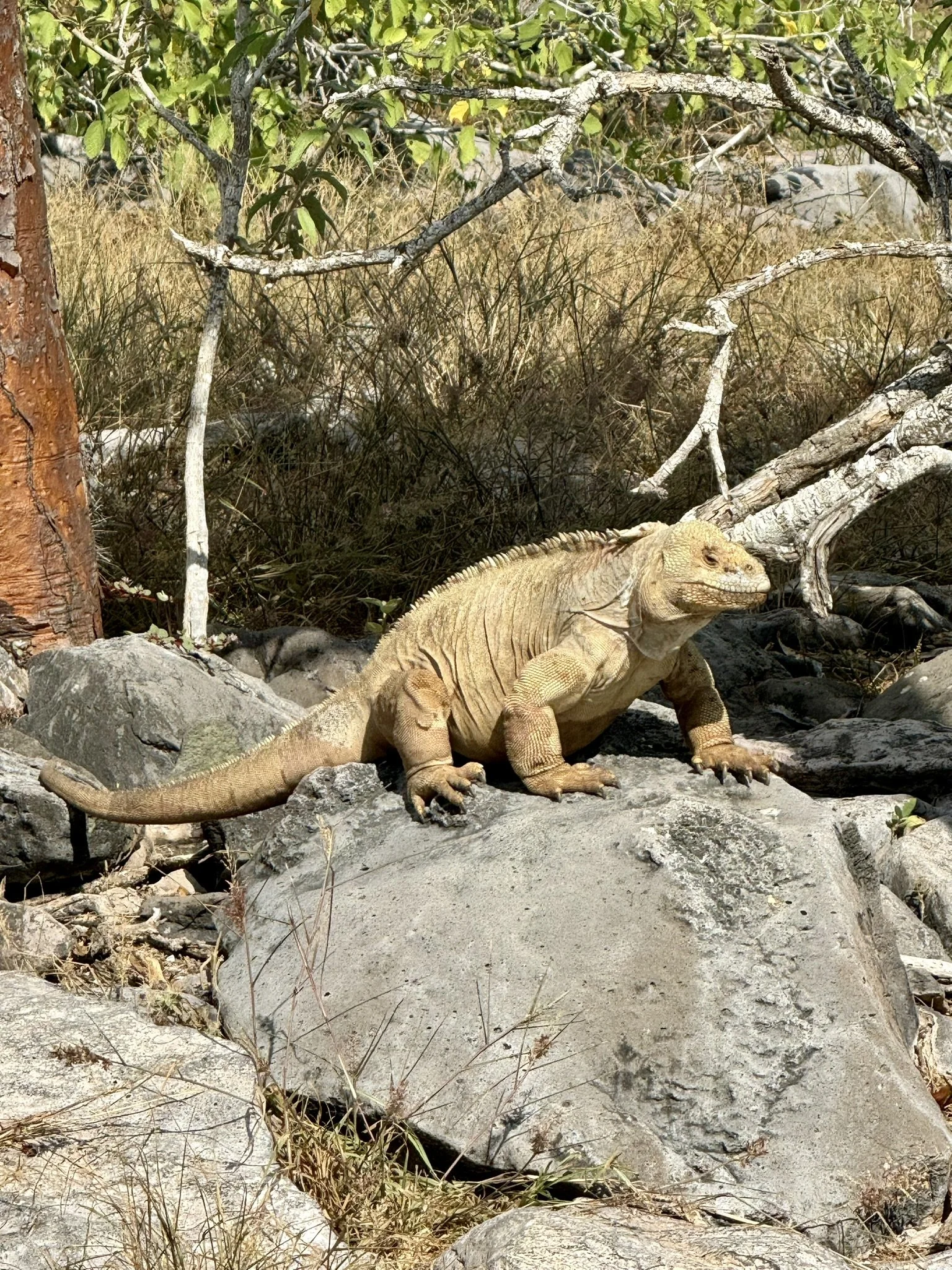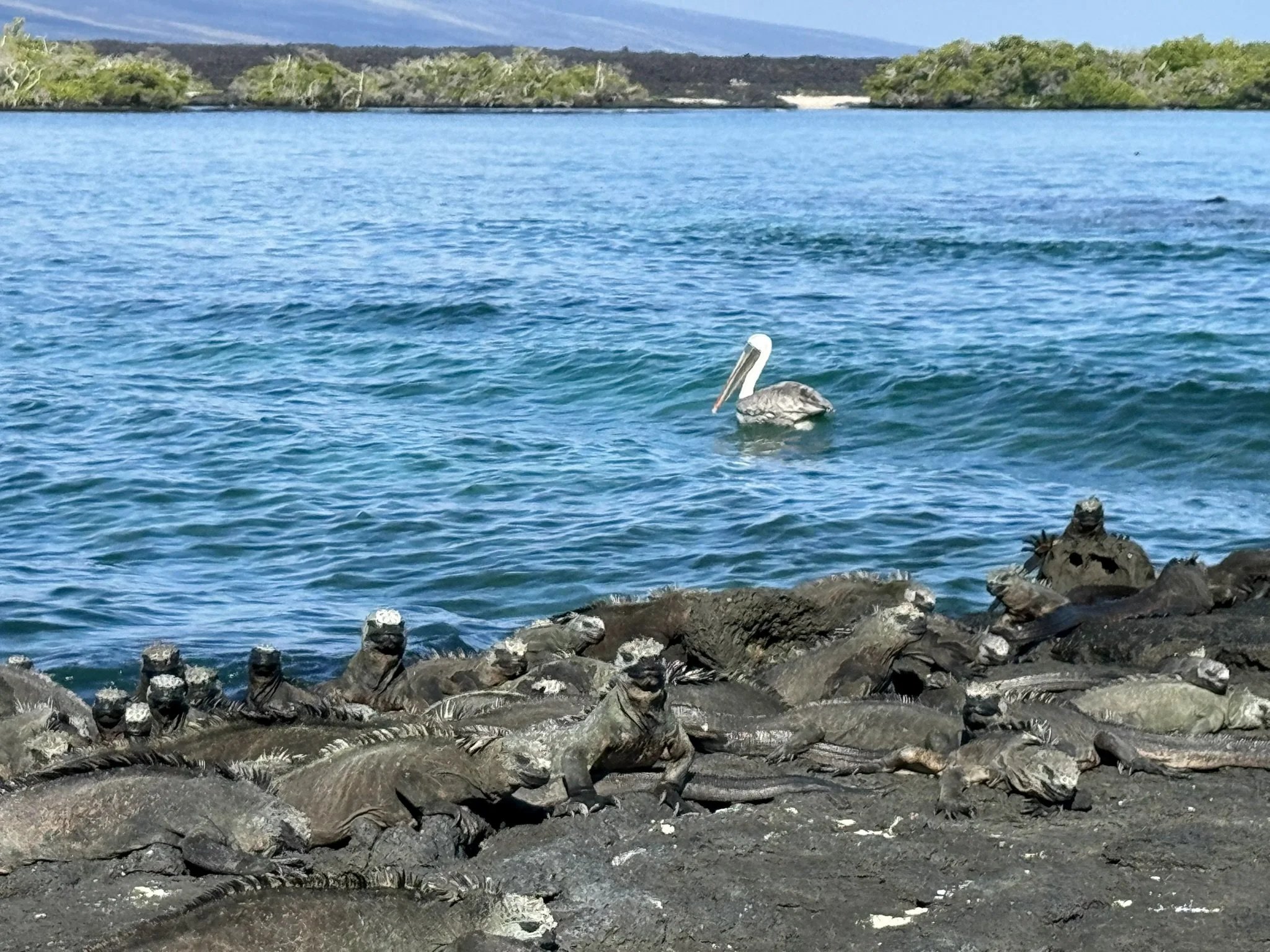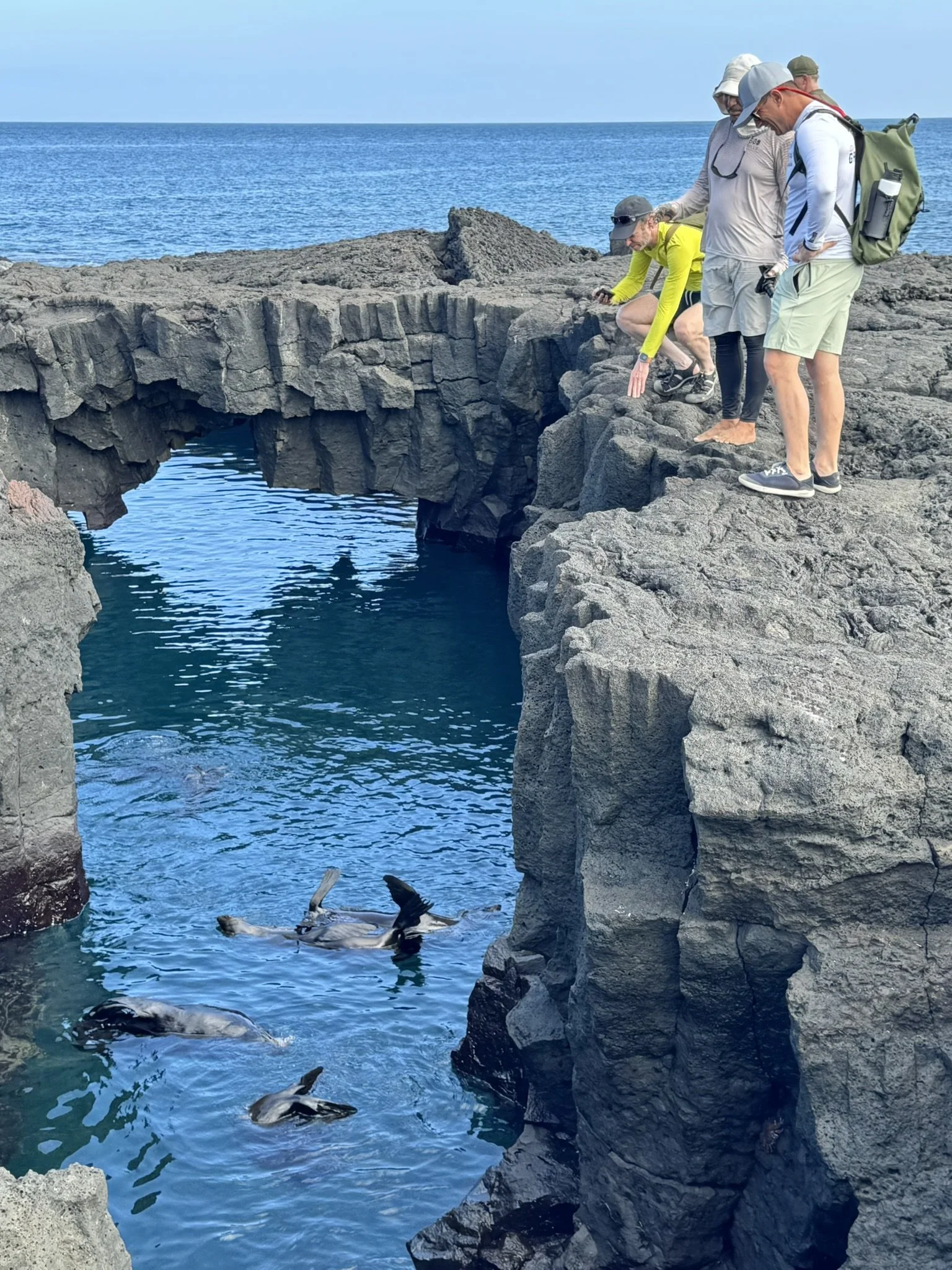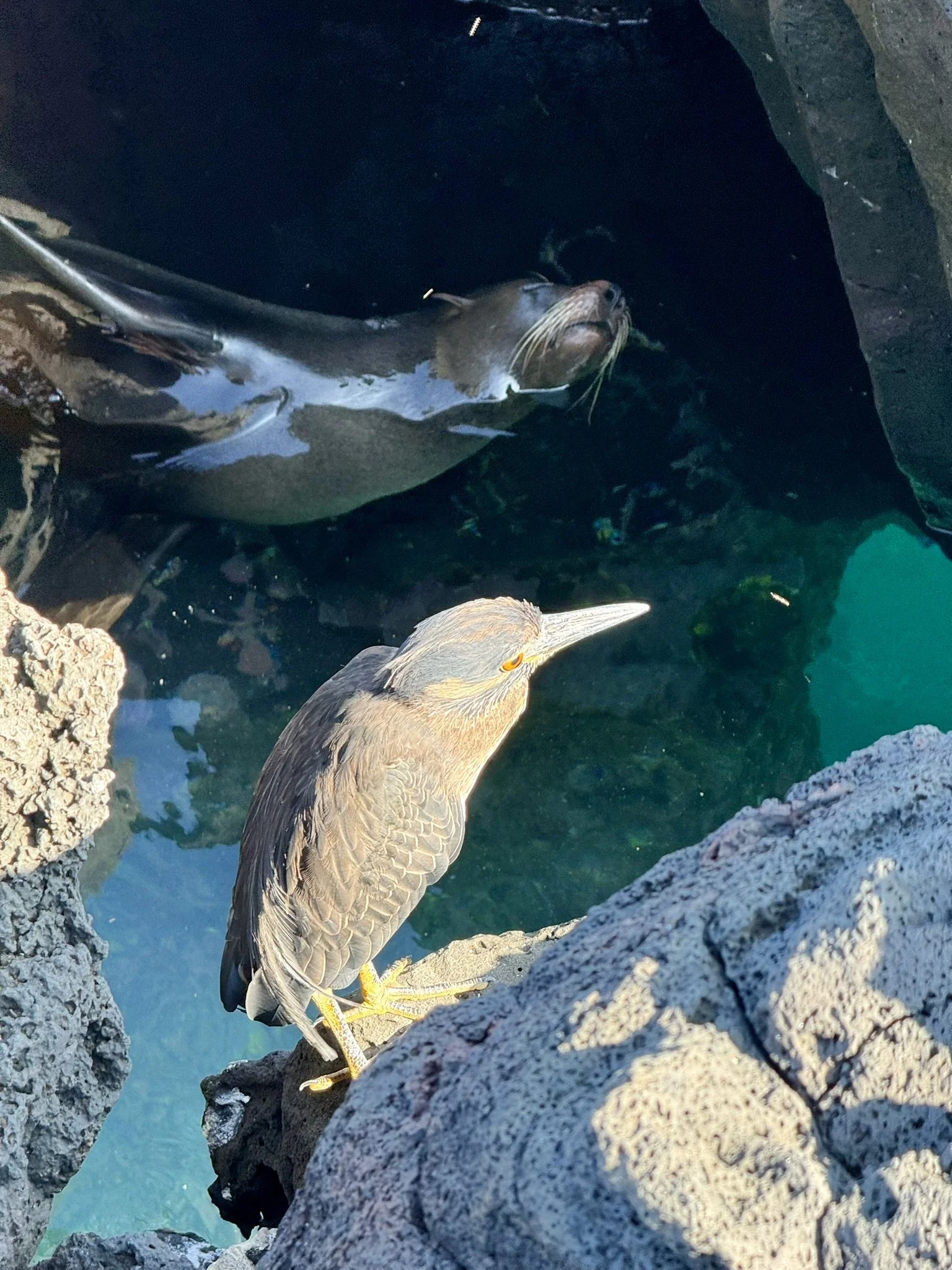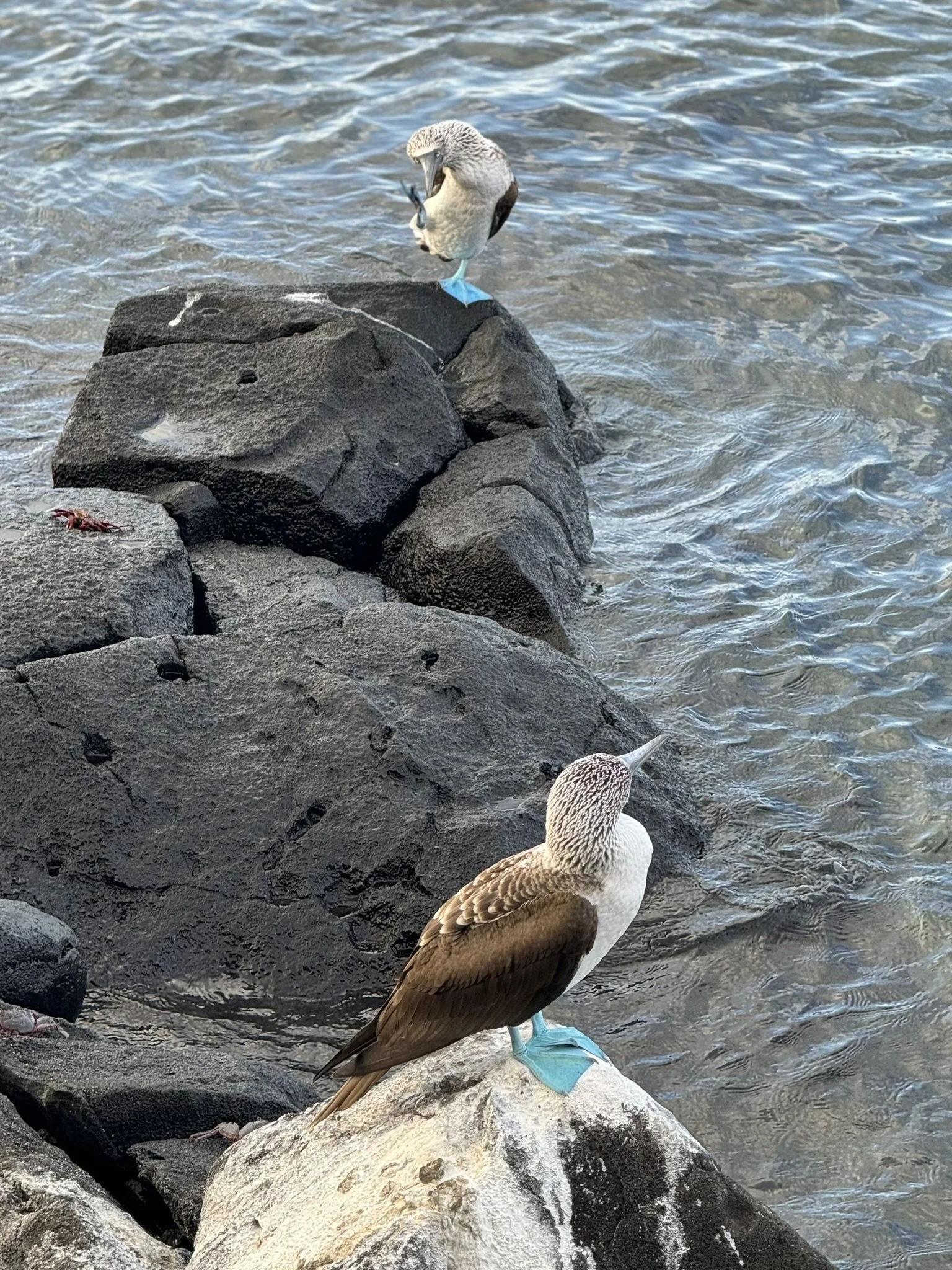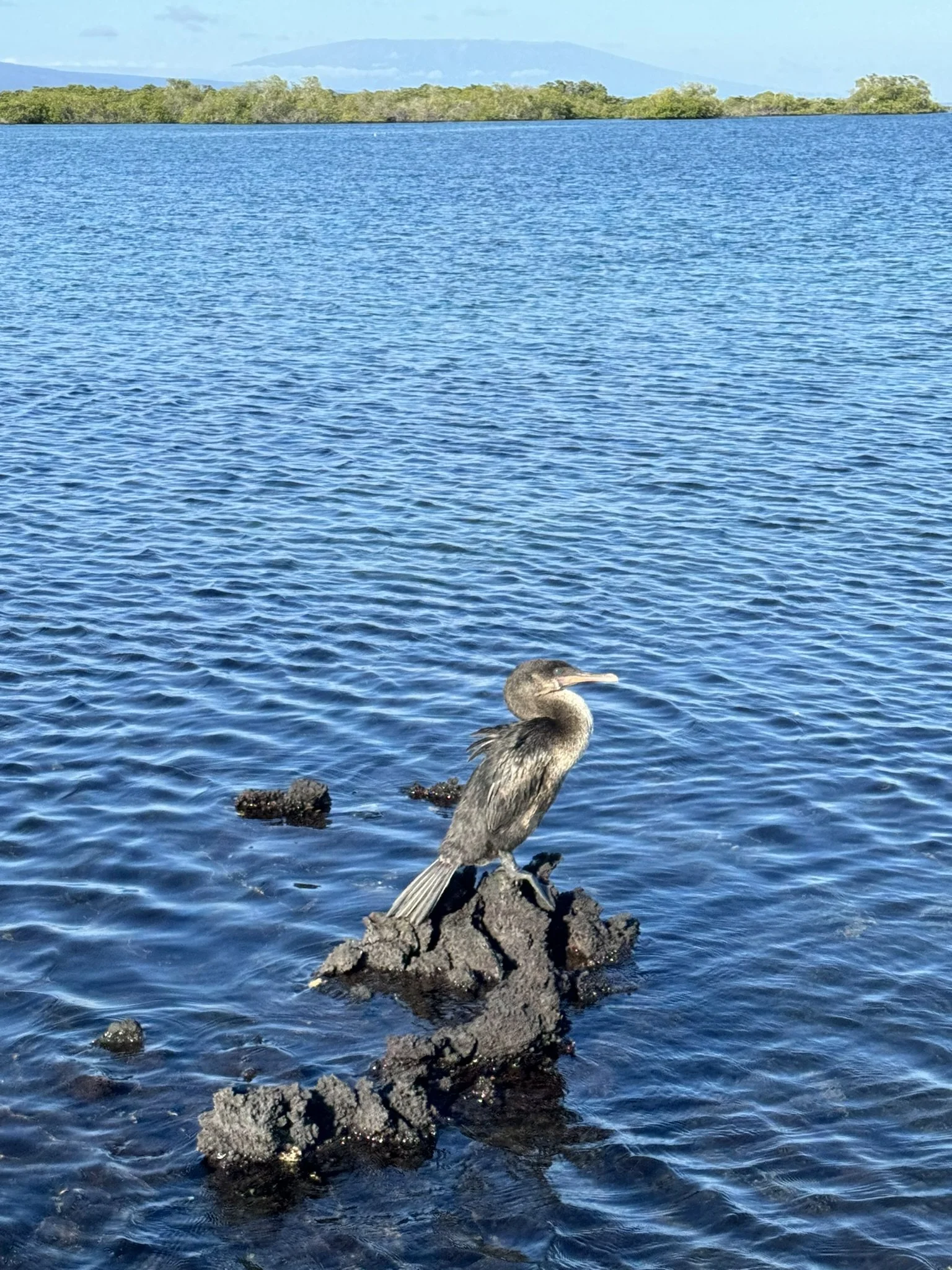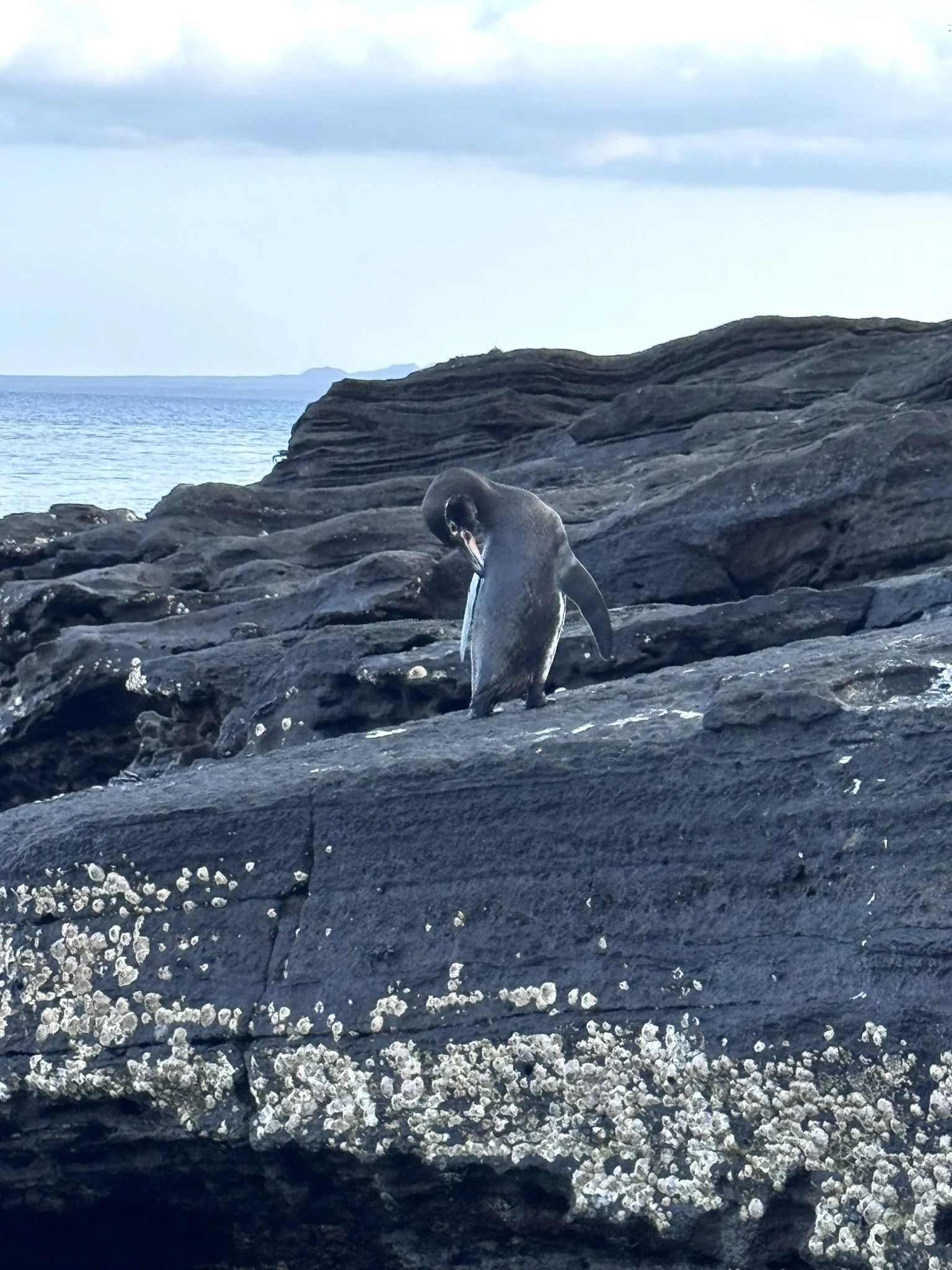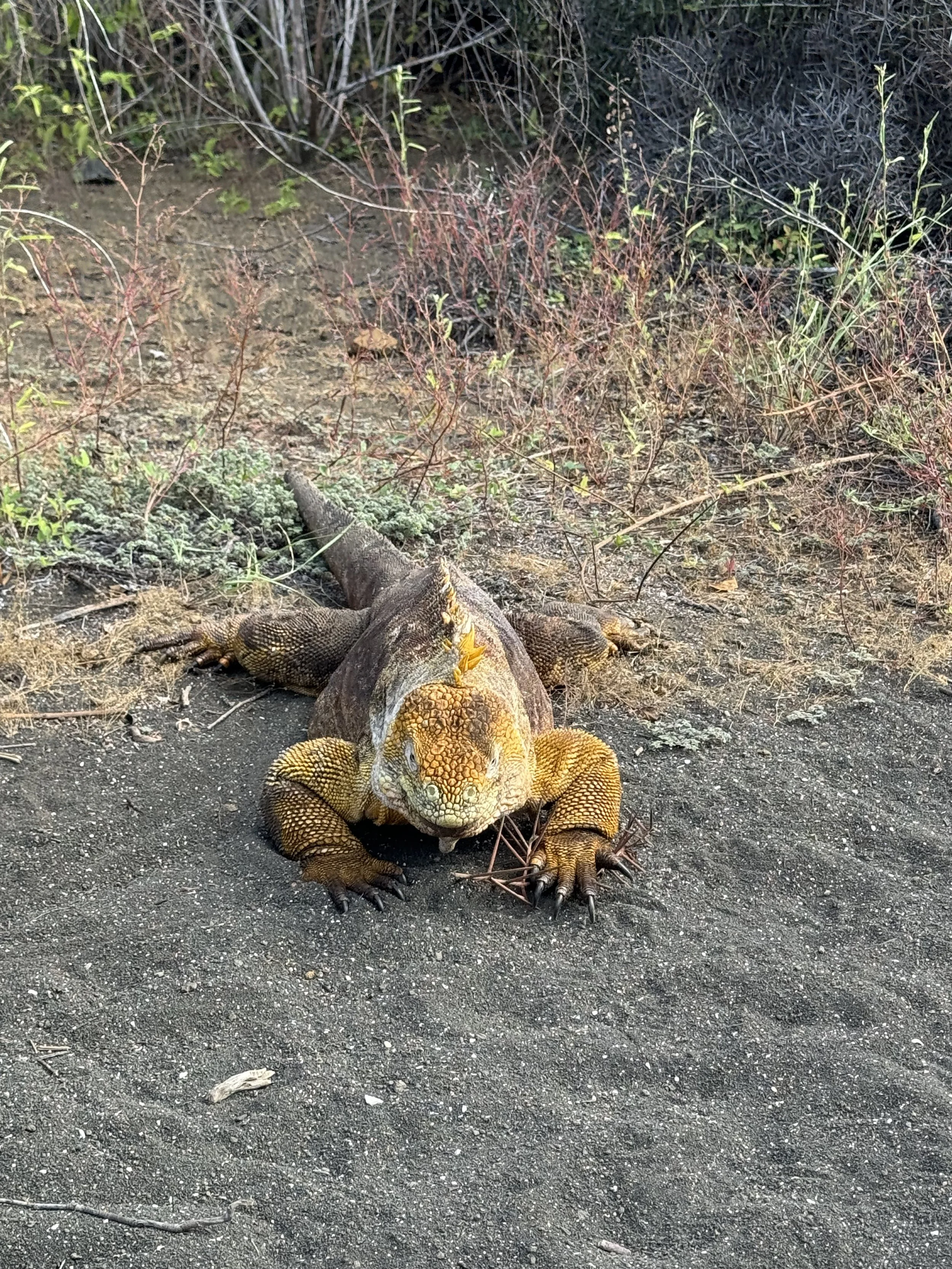The Ultimate Galápagos Wildlife Guide: Meet the Incredible Animals of the Enchanted Islands
The Galápagos Tortoise!
The Galápagos Islands offer some of the best wildlife viewing in the world. Every moment feels like living in a scene from a National Geographic documentary. From sea lions swimming right up to you while snorkeling, to watching the famed blue-footed boobies on sea cliffs, each island is a haven for unique creatures some of which can only be found in the Galapagos! The entire island chain offered the most amazing wildlife viewing we have ever experienced.
Snorkeling enthralled us with abundant sea life playing in their habitats, while above ground we observed some of the most amazing creatures, like the famed giant tortoises and land iguanas. Each day and each island brought new wildlife viewing experiences. We felt so close to nature and were awestruck at the different variety of species. These animals were masters of adapting to different and harsh climates. Observing them felt like stepping back in evolutionary time.
This guide will introduce you to some of the must-see animals of the Galápagos and where to find them—along with a few of our own unforgettable encounters!
Recommended Gear for Getting Those Amazing Shots
The Galapagos islands are a photographers and amateur picture takers dream! These untouched moments and habitats make for some incredible moments with the wildlife. You’ll want to both enjoy these raw and authentic moments…while also taking a thousand pictures and videos to relive the magic at home. Below is some recommended gear and equipment to make the most of your wildlife viewing experience:
GoPro or waterproof camera – Essential for capturing underwater moments, from playful sea lions to marine iguanas. We recommend a GoPro (with a waterproof handle) for high quality resolution, but really any action waterproof action cam will do the job. Just make sure to find one with high resolution to capture those epic underwater moments.
Camera with good zoom - For most people, I’d suggest finding an easy point and shoot digital camera that is compact, easy to carry, and easy to use. A camera with 20-40x zoom will do the trick to help you get those close up shots. If you are looking for something more professional, look into buying a DSLR camera which comes with more attachments and more customizable functionality - although there may be a bit of learning curve. If you are getting a DSLR camera for the first time, be sure to watch some videos on how to handle your settings before heading to the Galapagos. Otherwise, a point and shoot digital camera is the way to go for more casual picture takers!
Portable Charger - Trust us, you will be taking a ton of photos and videos, a good portable charger is something great to bring along to ensure your electronics are charged and ready to go! We like this one because it has several cords include which makes it very convenient without having to lug around several different type of cables and cords.
Telescopic lens kit for your smart phone - While not the most ideal situation, if you are on a budget and don’t want to bring another camera, a good telescopic lens kit can help give your iPhone or smartphone an extra bit of zoom. While the picture quality probably won’t be as great as a camera, a telescopic lens like this one can help with those shots requiring longer zoom.
Dry bag – Keeps valuables safe from water damage during boat rides and wet landings.
Neck Gaiter - A good neck gaiter is crucial to keep your neck and face from getting too sunburned. If you want to purchase one in the Galapagos, we really enjoyed Darwin and Wolf and highly recommend getting one from a local shop!
UPF Clothing like a rash guard or sun shirt can really help with the intense equatorial sun. We strongly recommend covering up especially while looking for wildlife because you may be exposed to the sun for quite some time while wandering through the beautiful islands.
Snorkel - While some tours provide snorkel gear, bringing your own ensures a better fit and more comfort for longer sessions. If you plan on snorkeling on the inhabited islands or on your own without a cruise or excursion, it’s a great idea to pack one. We recommend one that is semi-dry or dry as both contain a splash guard. Ash loves to dive down to get closer to marine life. This type of snorkel makes diving underwater seamless and avoids any water from getting into the J-tube.
Binoculars – Many species, such as frigatebirds and blue-footed boobies, nest on cliffs or in trees, making binoculars useful for better viewing.
Sunglasses (polarized if possible) – Helps reduce glare from the water, making it easier to spot wildlife like the spotted rays and sea turtles. Also consider bringing a floating sun glass strap to keep from losing your glasses during activities like paddle boarding and kayaking.
Land Iguanas: Evolving into separate species
Land Iguana on Santa Fe Island
A single iguana species evolved uniquely on each island, depending on the differences in habitat and food sources found there. This explains the three different Galápagos land iguana species found today: the common Galápagos land iguana, the Santa Fe land iguana (larger and more pale yellow in color), and the pink land iguana only recently found on Wolf Volcano, each with unique characteristics and distributions. These striking reptiles thrive in the dry, arid regions of the islands, basking in the sun and feeding on prickly pear cacti.
📍 Where to See Them: The Galápagos Land Iguana can be found on South Plaza, Santa Cruz (Cerro Dragón), and Isabela Island. The Santa Fe Iguana is its own species found on the island of Santa Fe. The pink iguanas are only found on Wolf Volcano on Isabela Island.
🗓 Best Time to See Them: Year-round, but they are most active after the rainy season when they have more access to food and water. Breeding times are different based on each island. You can often see them basking in the sun in the morning or afternoon when it is cooler or relaxing under the shade of trees during the heat of the day.
🔹 Our Experience: On our first full day of our Ecoventura cruise, we encountered the land iguanas dotted around the grassy terrain of South Plaza Island. A memorable moment was seeing a land iguana sharing some shade from the endemic opuntia cactus with a sea lion — both coexisting in complete harmony. Another unforgettable experience was hiking around Cerro Dragón in Santa Cruz where we followed a vibrant land iguana who became our tour guide, guiding us along the paved path for a solid 10 minutes before he turned off to snack on some flowers.
Land Iguanas at Cerro Dragon on Santa Cruz
The Marine Iguana: The only species that feed in the ocean
Marine Iguanas sunning on Fernandina Island.
The marine iguana is a true original and an endemic species to the Galápagos. These prehistoric-looking creatures dive into the ocean to munch on algae and bask in huddled groups on black lava rock to regain warmth in the sun. Watching them swim is absolutely baffling as is watching them “sneeze” out the salt from the ocean. They have special salt glands that allow them to rid the salt they ingest while feeding to prevent dehydration.
📍 Where to See Them: In the coastal areas of Fernandina Island (largest colonies), Tortuga Bay in Santa Cruz, Española, Isabela, and along the rocky shores in the port areas of Santa Cruz and San Cristobal.
🗓 Best Time to See Them: Year-round, but nesting season is from January to April.
🔹 Our Experience: Watching a marine iguana swimming right towards us while snorkeling was an out of this world experience. It felt as if small dinosaurs were paddling through the water right at us & they’d turn away at the last second. When these marine iguanas dive down to eat algae off of the rocks, it’s truly hard to describe how mesmerizing it is and how graceful these crazy looking iguanas actually are in the water. These were of our favorite species to observe!
Marine Iguana swimming
Playful Encounters: Galápagos Sea Lions
Sea Lion on Playa Mann
If there’s one animal that steals the show in the Galápagos, it’s the sea lion. These curious and playful creatures are everywhere—lounging on park benches, napping on the beach, and even popping up next to you while snorkeling. Sea lions can grow up to six feet, weigh up to 900 lbs (males), dive down 1900 feet, and hold their breath for up to 10 minutes! You’ll find the females to be extremely friendly and they will swim right up to you. The males are more protective and could get aggressive. It’s always best to keep your distance and let the wildlife check YOU out.
📍 Where to See Them: Sea Lions are everywhere on San Cristóbal (check out Playa Mann, La Lobería, and right in downtown Puerto Baquerizo Moreno ) and on Santa Cruz (right on Puerto Ayora docks). You can also see and swim with the Sea Lions on the islands of Santa Fe, Rabida, Santiago, and Bartolomé.
🗓 Best Time to See Them: Year-round, but pupping season (June–December) offers adorable baby sea lions.
🔹 Our Experience: I’ll never forget the sounds of hundreds of sea lions on the beaches on San Cristóbal. The sea lions out numbered the people! They were everywhere, laying on the park benches, relaxing on the beaches, and skirting the port area. It was honestly one of the coolest experiences to see where people and animals co-exist. We had some amazing snorkeling experiences with friendly and playful sea lions. One of my favorites was off the coast of the island of Isabela where three sea lions swam right up to us almost nose to nose. They were so curious and we watched them twirl and flip all around us and then quickly zip away. Another favorite experience was snorkeling off of the Island of Rabida. We snorkeled with a small family of sea lions who kept swimming up to us and wanted to play. It was such a surreal experience!
Playful Sea Lions
Elusive & Adorable: Galápagos Fur Seals
The Galápagos fur seals at Egas Port on Santiago Island
Often mistaken for sea lions, Galápagos fur seals are smaller, shyer, and tend to avoid human interaction. They have thick fur coats and are mostly active at night, making them harder to spot. This makes spotting them special. Fur seals are much smaller than sea lions at only 3-4 feet long and weigh up to 140 lbs.
📍 Where to See Them: Fur seals like to relax in the shade and on rocky shorelines. You can find them on Fernandina Island, Isabela Island, Genovesa, and Santiago along the rocky shorelines.
🗓 Best Time to See Them: Year-round, but most active in the cooler months (June–November). The best time to see the fur seal pups is in October.
🔹 Our Experience: Watching a fur seal nap in the shade of a lava rock on Santiago Island was a reminder of how peaceful and untouched nature can be in the Galápagos. We also could have watched the fur seal yoga all day. We saw at least 20 fur seals all over the rocky shoreline of Egas Port with a few napping in the natural pools, with their heads above water, and foot and flipper above their head floating in a yoga pose. Since the fur seals can be hard to spot, this made the experience all the more magical.
A fur seal with a lava heron at Egas Port on Santiago Island
The Famous Boobies: Blue, Red, & Nazca
A Nazca Booby perched on a rock
The Galápagos is home to not one, but three species of boobies—each with its own unique charm. The boobies are such special bird species to the Galapagos making observing them a wonderful experience. The first time we saw the blue-footed boobies was on the rocks of Puerto Baquerizo Moreno on the island of San Cristobal. These birds are so photogenic with their head tilts and blue feet. These were some of our favorite birds we saw in the Galapagos. We also loved the Nazca booby. The Nazca booby likes to perch on high cliffs and has a very unique black “face mask”. We really enjoyed observing them.
🐦 Blue-footed Boobies: Their bright blue feet and hilarious courtship dance make them an island favorite.
🐦 Red-footed Boobies: The rarest of the three, often found perched in trees.
🐦 Nazca Boobies: Larger and more regal, with striking black markings.
📍 Where to See Them: Española Island, North Seymour, & San Cristobal (best for blue-footed boobies), Genovesa Island (red-footed boobies), San Cristóbal & Española (Nazca boobies). The Daphne Major & Minor are also important islands for nesting for both the blue-footed & Nazca boobies.
🗓 Best Time to See Them: You can see the boobies year-round, but the best time to observe them is July and August during their breeding season when they are most active on land.
🔹 Our Experience: Seeing the blue feet just brings a smile to your face. The first time we saw these adorable birds we were wandering along the port of Puerto Baquerizo Moreno on San Cristobal. These beautiful birds were soaring and diving from along the port, flying up incredible heights and then diving down to catch their prey. When they were finished hunting they would land on the rocks right in the port, blue feet gleaming off of the grey rocks. While they can look dopey or clumsy on land, they are quite skilled divers and hunters. We encountered the blue-footed boobies many times throughout our trip and each time we felt delightfully giddy.
The famous blue-footed boobies
Unique Bird: Flightless Cormorant
Flightless Cormorant on Isabela Island
One of the rarest birds in the world, the Flightless Cormorant here has evolved to thrive without flight, developing powerful legs and webbed feet for expert diving and swimming. This unique bird is the only cormorant species that has lost the ability to fly, adapting instead to an aquatic lifestyle to hunt for fish, eels, and octopuses!
📍 Where to See Them: Exclusively found on Fernandina and Isabela Islands, near rocky shorelines and lava flows.
🗓 Best Time to See Them: Year-round, with nesting and breeding activity peaking from May to October.
🔹Our Experience: We saw the flightless cormorants relaxing on the rocks in Elizabeth Bay and in Tagus Cove on Isabela Island. Their small wings are very amazing to see especially if you have seen high flying cormorants before. They are amazing swimmers and watching them dive into the water and speed through the water was impressive. We were so excited to see these flightless cormorants since the Galápagos Islands are the only place to see them!
The flapping flightless cormorant
One of our favorites: Galápagos Penguins
A beautiful Galápagos Penguin
The only penguins living north of the equator and are endemic to the Galápagos. The species are the second smallest penguins in the world.
📍 Where to See Them: Isabela, Fernandina, & a very small population in Bartolomé
🗓 Best Time to See Them: Though penguins can be seen year round, activity is the highest June to November when the water is cool and nutrient rich.
🔹 Our Experience: One of our highlights was seeing the Galapagos Penguin. We were fortunate to see the adorable penguins on coasts cliffs shaking their tail feathers and zipping by us like a torpedo when we were snorkeling and on our zodiac boat tour off the west coast of Isabela.
Galapagos Penguin
Gentle Giants: Galápagos Tortoises
A Giant Tortoise at El Chato Tortoise Reserve on Santa Cruz Island
Nothing says “Galápagos” quite like its iconic giant tortoises, some of which live for over 100 years! These slow-moving reptiles helped inspire Darwin’s theory of evolution. Each tortoise is slightly different depending on which island they are endemic. We learned a lot from our guides about these gentle giants, but one of the most fascinating facts was how to identify the island from which the tortoise was from based on their shell shape, domed or saddleback. Even though these tortoises are from the same island chain, their shells have evolved based on the island environment & whether their food source is from the ground or if they need to raise their necks higher to eat. Take some time to truly observe and watch these amazing creatures.
📍 Where to See Them: Santa Cruz (El Chato Tortoise Reserve), Isabela Island (Arnaldo Tupiza Breeding Center)
🗓 Best Time to See Them: Year-round, but mating season is from January to June, and hatching season is from December to April.
🔹 Our Experience: The El Chato Tortoise Reserve was a really great place to see tons of tortoises wandering around the reserve; however, seeing the giant tortoise in the wild on the island of Isabela was surreal. The tortoise was hiding underneath a tree to stay cool from the hot sun and we watched it crawl slowly out to grab a snack. A truly magical moment.
Giant Tortoise Wandering
Underwater Wonders: Sharks, Rays, Sea Turtles, & Starfish

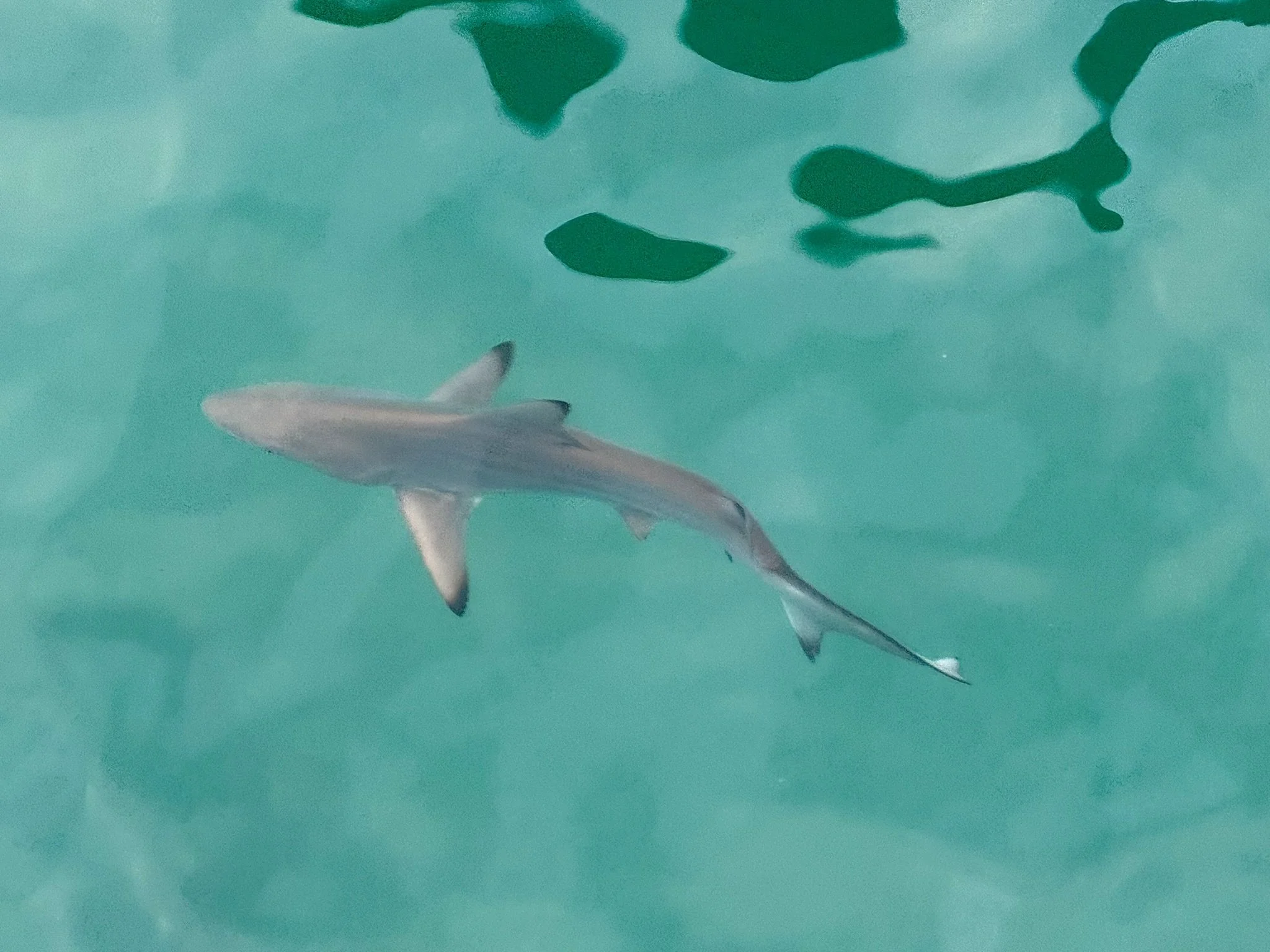
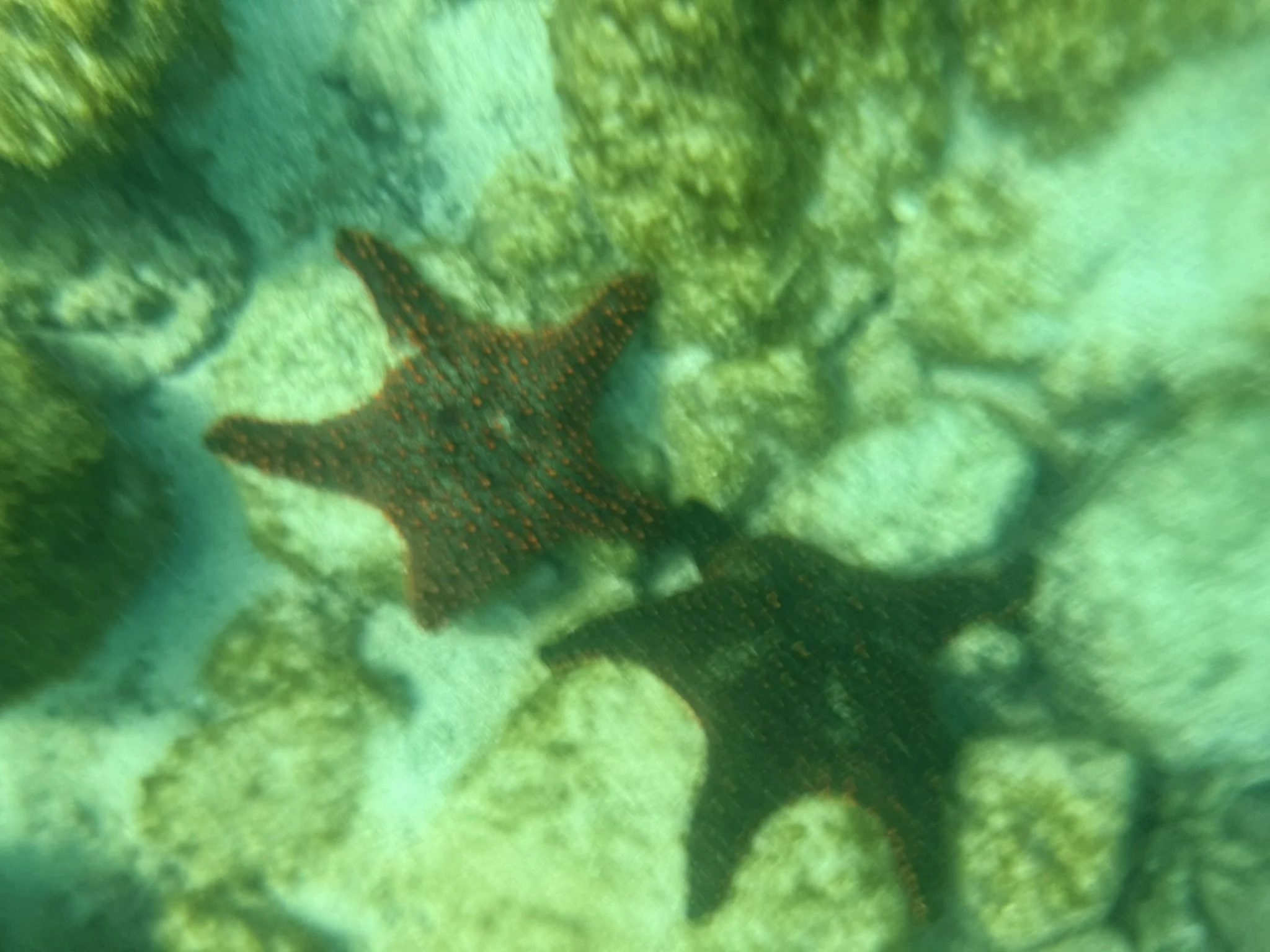
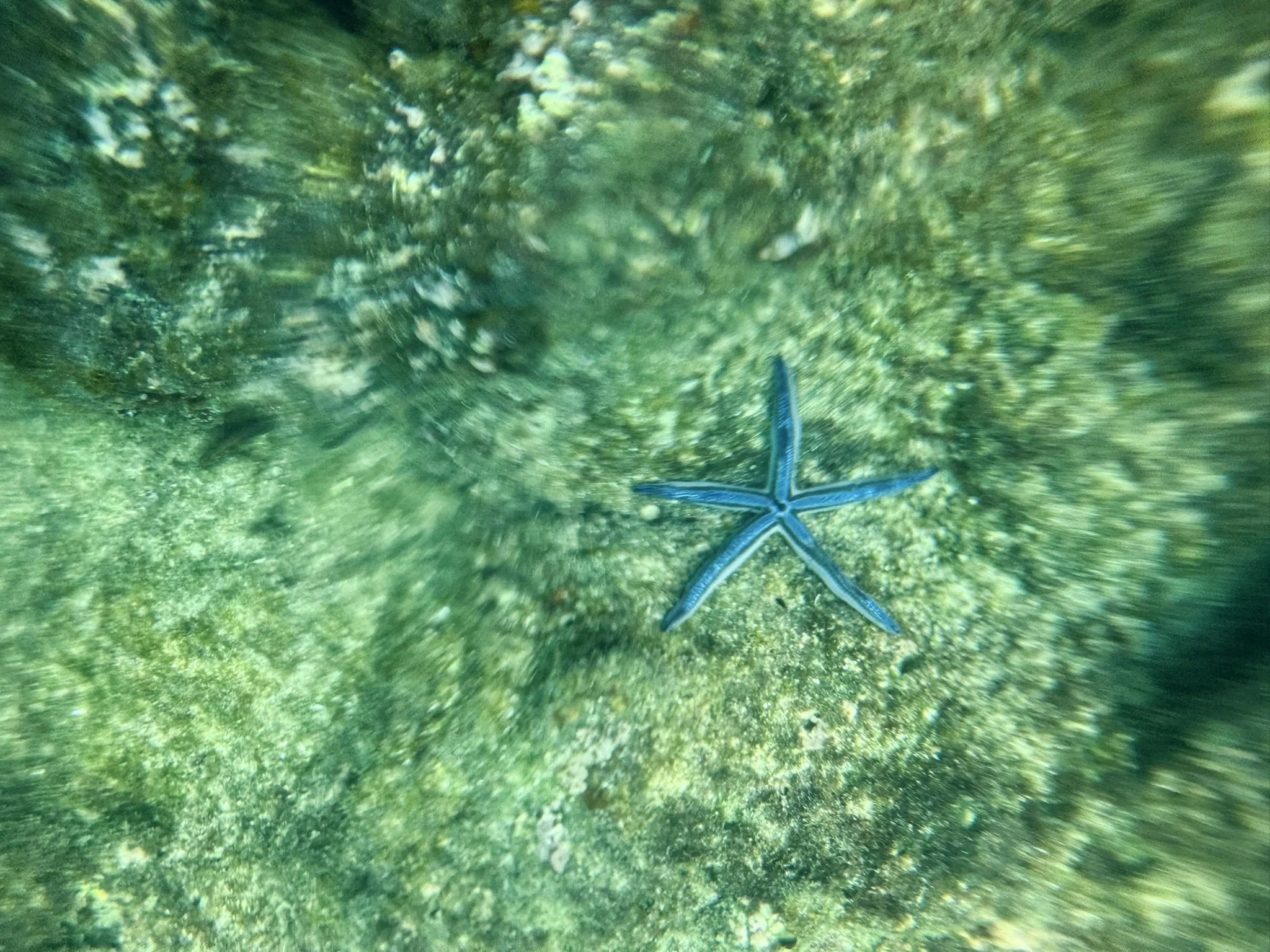


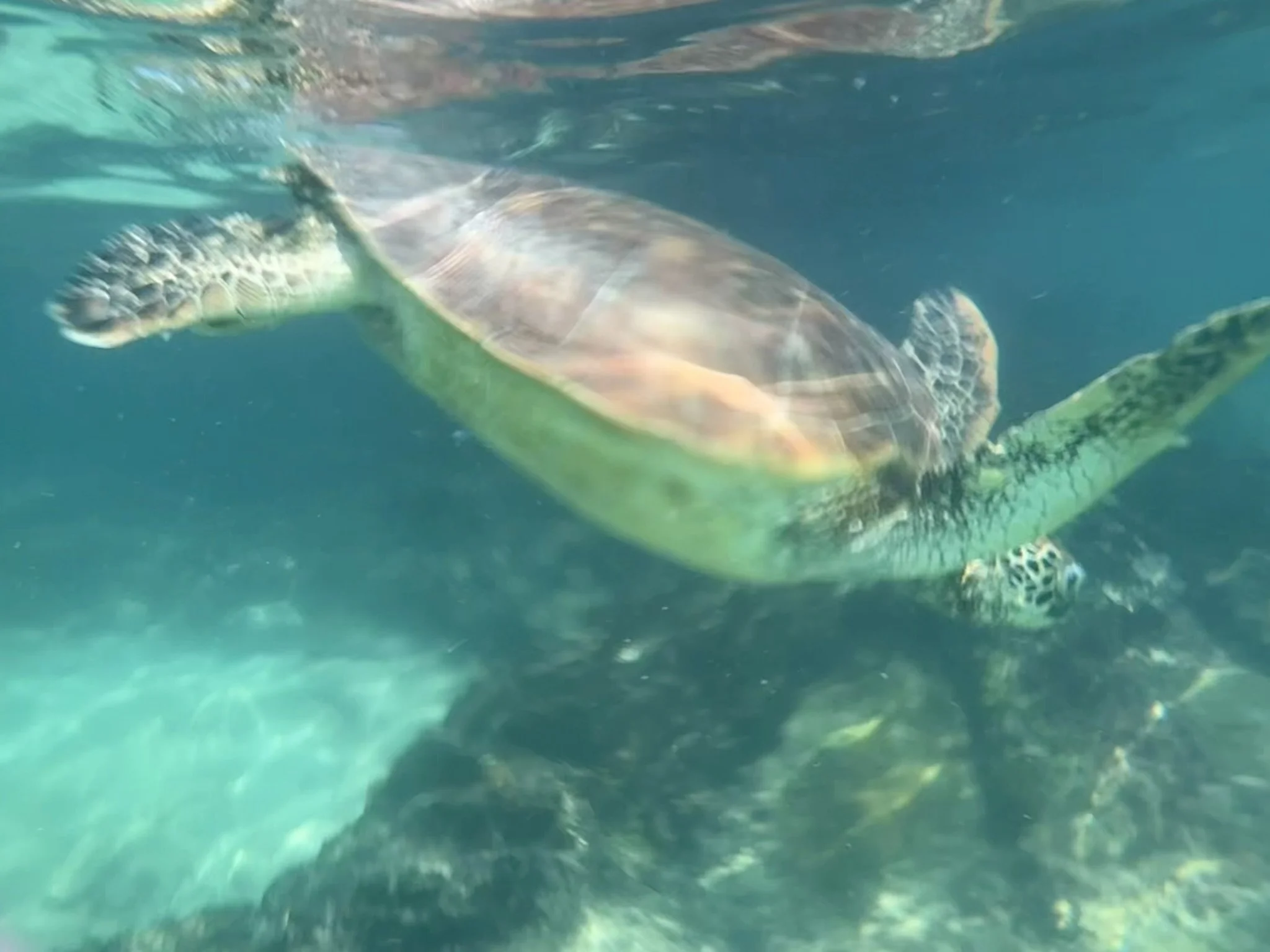

The Galápagos marine life is just as impressive as what’s on land.
🦈 Galápagos Sharks, Black & Whitetip Reef Sharks, & Hammerhead Sharks: Often spotted while snorkeling or diving over the continental shelves and near the shelf breaks. Hammerheads are found in the much deeper diving areas.
🐢 Green Sea Turtles: Graceful creatures seen gliding through the water and feeding on rocks.
🌀 Eagle Rays & Golden Rays: Beautiful and mesmerizing as they glide in formation.
⭐Starfish - There are quite a few species of starfish in the Galápagos including the blue sea star, Galápagos starfish, and the chocolate chip star fish. We found these during a few of our snorkel excursions along the rocky sea walls and blanketing the rocky bottoms around 3 meters below the surface.
📍 Where to See Them:
Galapagos sharks & Hammerheads: Kicker Rock and off of Darwin & Wolf Islands (the latter being the most remote islands in the archipelago and wonderful for diving)
Black & Whitetip reef sharks: Snorkeling around Egas Port in Santiago, Rabida, and seen off of the pier at Puerto Ayora in Santa Cruz
Spotted Eagle Rays and Golden Rays: Elizabeth Bay on Isabela Island, Black Turtle Cove on Santa Cruz, and at Bartolomé Island. If interested in seeing the Giant Manta Rays, these can grow up to 26 ft and can be found swimming in the waters around Darwin & Wolf.
Galapagos Sea Turtles: Sea turtles can be found in the water around every Galápagos Island. There is a nesting site at Bachas Beach in Santa Cruz where we saw their flipper prints across the sand and a nesting area roped off. Another nesting area is Punta Cormorant on Floreana island.
Starfish: We saw many Galápagos starfish while stand up paddle boarding in Tagus Cove at Isabela Island and we were able to observe many species snorkeling near Cerro Dragon on Isabela Island.
🗓 Best Time to See Them:
December to March: During this time sea turtles will be nesting and they will hatch around May; though, the Galapagos sea turtle can be found year-round. These months are also the best for viewing rays due to the warmer and clearer waters.
June to November: Sharks can be seen year round but activity is the highest during this time when the water is cool and nutrient rich.
🔹 Our Experience: We saw the green sea turtles on almost every single snorkel. Each time was as amazing as the last and following them around and watching as they would feed off of the algae on the rocks. We felt very fortunate to see both the eagle and golden rays swim past while we were on a zodiac tour off the coast of Isabela in Elizabeth Bay. One of our favorite moments was snorkeling in Egas Port and both blacktip and whitetip reef sharks swam right by us. We followed at a distance and found quite a few lounging in a cave. A moment of pure awe!
Spotted Eagle Rays
Whitetip Reef Sharks
More Incredible Wildlife to Spot









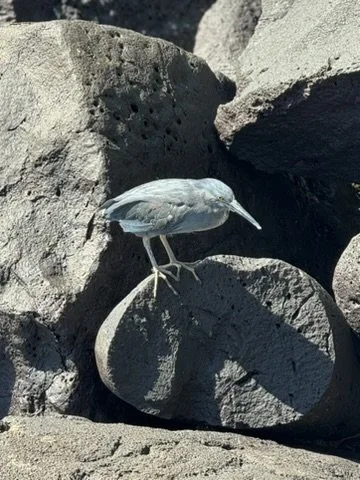


Darwin’s Finches – 13+ species, each with a unique beak shape, key to Darwin’s evolution studies.
Frigate Birds – Males inflate their red throat pouches to attract mates. These massive birds followed our cruise around the entire week.
Lava Lizards – Small but feisty, often doing push-ups to defend their territory. They are quick and small so take care when walking around the islands - they are hard to see when they’re right by your feet!
Sally Lightfoot Crabs – Bright red crabs scuttling along the shoreline. These crabs are rumored to have been named after a Caribbean dancer. They are able to climb vertical slopes and have great agility.
Galápagos Dove – These birds have beautiful patterns and although they are quite common around the islands, can be difficult to spot. They have a very distinct blue eye ring that makes them truly stand out.
Galápagos Flamingo: One of the rarest flamingo species, the Galápagos flamingo, is known for its vibrant pink plumage, long legs, and graceful movements in shallow lagoons. These flamingos are primarily found in saltwater lagoons on Floreana, Isabela, Santiago, Rabida, and Santa Cruz Islands.
Lava Heron: An endemic species to the islands, also known as the Galápagos Heron, live and nest along the lava rock which is a great camouflage for their gray color.
Swallow-Tailed Gull: Endemic to the Galápagos Islands, these birds are the only noctural gull. They are pearly gray with a distinct red eye ring, and their eyes are adapted to night vision to forage on small fish and squid. They nest directly on lava rock and cliff areas along the shore.
Galapagos Hawk: This is the only bird of prey found in the Galápagos. This is also an endemic species, found no where else in the world. They feed on lava lizards, young land and marine iguanas, snakes, small rodents, and other birds.
Waved Albatross: Critically endangered, the waved albatross is the largest bird in the Galápagos and is famous for its elegant gliding and elaborate courtship rituals. These birds mate for life and return to the islands each year to breed. They are beautiful birds with a massive wingspan of over 8 feet! Aside from a very tiny breeding colony off of the coast of Ecuador, the Española Island is the only known major breeding ground of the waved albatross in the world, specifically at Punta Suárez.
Wildlife & Ecotourism: How to Respect the Galápagos
While enjoying the incredible biodiversity, it’s important to be a responsible traveler:
✔️ Keep Your Distance – Always follow the park’s rule of staying at least 6 feet away from animals.
✔️ No Touching or Feeding – This disrupts their natural behaviors.
✔️ Use Reef-Safe Sunscreen – Protects marine life while snorkeling.
✔️ Follow Local Guides – They ensure safe and sustainable wildlife viewing.
✔️ Opt for a refillable water bottle and a reusable shopping bag for snacks, groceries, or shopping on the inhabited islands. Single use plastics are prohibited in the islands.
Final Thoughts
Visiting the Galápagos is like stepping into a nature documentary. Every day is an adventure, whether you're watching a sea lion pup chase waves, spotting a giant tortoise slowly making its way through the highlands, or gliding alongside a school of golden rays. The best way to describe this experience is having a pure dopamine rush. We felt like each experience kept topping the next, day after day. If you’re a nature lover, this is the ultimate bucket-list destination!
Land Iguana on Santiago Island
We hope this guide helps you to experience and observe all of the amazing wildlife the Galapagos has to offer!
Check out our other Galapagos blogs:
Disclosure: This post contains affiliate links, which means we may earn a small commission (at no cost to you) if you book or purchase through our links. We only recommend things we’ve personally used and loved. Thanks for supporting our blog!
✨ Ready to plan your own Galapagos escape?
Check prices for Galapagos Hotels or browse tours around the Galapagos to get started!

